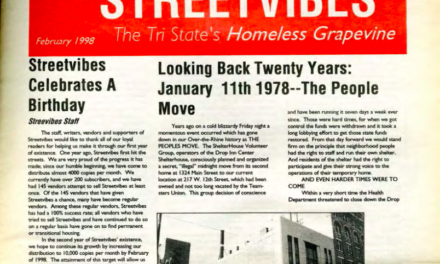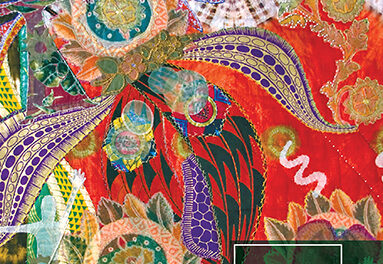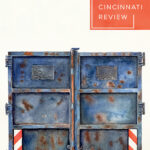For our third collaborative feature with Cincinnati’s online magazine Soapbox, we’re featuring Brian Barker’s prose poem “Bats” from issue 9.1. Soapbox tells the new Cincinnati story—a narrative of creative people and businesses, new development, cool places to live, and the best places to work and play. And every other month, Cincinnati Review will contribute some of the best lit—poetry, fiction, and nonfiction—in the country. Here, we’ve reprinted Barker’s “Bats” in full, as well as “bonus material” in the form of comments from the writer and our staff, including the editor who accepted the piece for publication—also on the Soapbox website.
Bats
They will crawl out of the ashes of cold barbecue pits. Their wings will be cut from the backs of chimney sweeps. They will hang from the antlers of an elk like a congress of drowsy trapeze artists. At dusk above houses, they will appear and disappear and appear, weaving a jagged cotillion through the trees. Their songs will travel before them like aneurysms on strings, shattering streetlights, car alarms, nerves. When winter comes too early, we will see their faces in our frostbitten fruit. Insomniac, they will be your alphabet at the window. Sleeper, they will be the jewelry of your death, tangled in silk pajamas, in a wet beehive of hair.
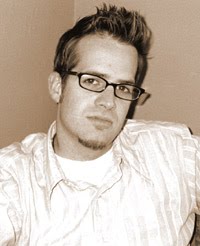 Brian Barker: This poem belongs to a sequence of linked prose poems I’ve been working on recently called “Natural Histories.” Each poem in this sequence concerns a different animal, and the poems are linked in that animal images, which occur organically within the poems, dictate the subjects. For example, the poem that precedes “Bats” is “Hippopotamuses,” where I write: “When they belch, fruit bats will glide from the caves of their stomachs and startle the moonlight.” The poem that occurs after “Bats” is “Elk,” following from the line, “They will hang from the antlers of an elk like a congress of drowsy trapeze artists.”
Brian Barker: This poem belongs to a sequence of linked prose poems I’ve been working on recently called “Natural Histories.” Each poem in this sequence concerns a different animal, and the poems are linked in that animal images, which occur organically within the poems, dictate the subjects. For example, the poem that precedes “Bats” is “Hippopotamuses,” where I write: “When they belch, fruit bats will glide from the caves of their stomachs and startle the moonlight.” The poem that occurs after “Bats” is “Elk,” following from the line, “They will hang from the antlers of an elk like a congress of drowsy trapeze artists.”
I say that the images occur organically because I’m not working from a list of particular creatures I’d like to write about. The animals appear naturally and feel unforced. This kind of formal constraint, like other formal constraints in poetry, imposes restrictions. That is, at times I end up with animals that I don’t know how to write about, or didn’t anticipate writing about, and I have to find an imaginative way through such impasses.
Bats, on the other hand, felt like a gift. I’ve always had a mixture of fascination about and fear of bats. They are strange beings with their furry, fox-like faces and exaggerated ears, and those wings—the thin, leathery skin stretched over dainty bones—look a bit like a botched experiment. I’ve spent many summer evenings watching them weave through my neighborhood, a flight that seems to vacillate violently between the graceful and the erratic.
This poem, like all of the poems in the “Natural Histories” series, mixes the factual with the mythic, and exploits the simple future verb tense (“They will”), which lends a mystery to the voice. Who speaks with such authority? Where are we in time? The poems, in my mind, seem to emanate from some otherworldly force out of a black void, as much creation myth as natural history.
In the poem, I have tried to capture the fear and the revulsion that so many people feel about bats. No matter how many insects they may eat, it’s hard to shake the notion that all bats are rabid, cunning bedroom invaders looking for a tender neck to suckle. And yet, they are amazing creatures! The only mammals that can fly, they are equipped with echolocation and spend much of their lives hanging upside down. When I watch them “appear and disappear and appear” above the houses in my neighborhood, it’s hard not to think of them urgently tracing a kind of alphabet in the sky, a message from one mammal to another that must be decoded before the dusk deepens into dark.
Lisa Ampleman: When I think of references to bats in poetry, I hear the final line of Robert Hass’s “Happiness”—“our eyes squinched up like bats”—or Ariel’s song in The Tempest: “On the bat’s back I do fly/ After summer merrily.” Such happy bats in those poems, the graceful divers of summer twilight.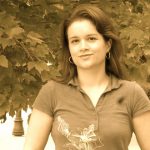
Brian Barker’s bats are not that kind. They dance the cotillion, yes, but Barker aligns them with ashes, chimneys, aneurysms, car alarms, and frostbite. And, he reminds us of our worst fear of them: that they could become entangled in our hair. His are the bats of late October, as the evenings begin to cool and darken, when night-creatures are more threatening.
His form, the prose poem, uses the qualities of both genres: it moves by a series of associations and employs figurative language, while retaining the rhythms and formatting of prose. Though it’s been prevalent in other movements and time periods, the prose poem is closely associated with nineteenth-century French Symbolists, such as Baudelaire and Mallarmé. I like the description of prose poetry that the Academy of American Poets uses, from Peter Johnson, the editor of The Prose Poem: An International Journal: “Just as black humor straddles the fine line between comedy and tragedy, so the prose poem plants one foot in prose, the other in poetry, both heels resting precariously on banana peels.” Barker’s poem feels at once like a lyrical ode and a paragraph in an odd naturalist’s guide.
 Brian Brodeur: I love the startling and often disturbing associative leaps in Barker’s prose poem. It opens, not with the phoenix of Eurasian mythology, but with the drowsy resurrection of bats. This local, suburban version of the classical creature “crawl[s]” instead of flies “out of the ashes of barbeque pits.” Moving from these backyard “ashes” to those caked on the “backs of chimney sweeps,” bats become the strange earrings adorning the “antlers of elk,” then transform once again into “a congress of trapeze artists,” a metaphor that suggests the precarious way bats hang by their toes to sleep. Like William Blake’s chimney sweeper, who is “a little black thing among the snow,” Barker’s “little black thing[s]” are conspicuous in spite of their smallness, speed, and nocturnal nature. Indeed, their “songs” are so loud they “shatter . . . streetlights, car alarms, nerves.”
Brian Brodeur: I love the startling and often disturbing associative leaps in Barker’s prose poem. It opens, not with the phoenix of Eurasian mythology, but with the drowsy resurrection of bats. This local, suburban version of the classical creature “crawl[s]” instead of flies “out of the ashes of barbeque pits.” Moving from these backyard “ashes” to those caked on the “backs of chimney sweeps,” bats become the strange earrings adorning the “antlers of elk,” then transform once again into “a congress of trapeze artists,” a metaphor that suggests the precarious way bats hang by their toes to sleep. Like William Blake’s chimney sweeper, who is “a little black thing among the snow,” Barker’s “little black thing[s]” are conspicuous in spite of their smallness, speed, and nocturnal nature. Indeed, their “songs” are so loud they “shatter . . . streetlights, car alarms, nerves.”
As early practitioners of the prose poem understood, this hybrid form often employs rapid turns and contradictory perceptions, making it a great vehicle for nightmarish ideas and images Barker exploits in “Bats” (e.g., “aneurisms on string”). But I’d wager even Aloysius Bertrand, often cited as being the first to work with the form, would be envious of Barker’s image of these winged mammals as “weaving a jagged cotillion through the trees.”
Don Bogen: When I first came across Brian Barker’s “Bats,” I was struck by the strange use of future tense the poet himself mentions. That, coupled with the generalized “they” and “their” that appear in every sentence—we never see an  individual bat but only bats en masse—lend an oracular quality to the piece, as if it were a dark prophecy of their future invasion. And they will be everywhere: from the skies above our houses, to the food in our hands, to the insides of our dreams—or should I say nightmares? The increasingly ominous tone of the poem adds to its sleek movement as it progresses from the mild discomfort of “cold barbecue pits” to “aneurysms,” “frostbitten fruit” (surely an echo of “forbidden fruit”), and at last “the jewelry of your death”—not a generalized “our death” but yours, reader, tonight most likely, in your sleep (cue demonic laughter). Well, it is only a dream, and Barker’s hint of humor throughout keeps us from having to spend the rest of our evening awake behind locked doors.
individual bat but only bats en masse—lend an oracular quality to the piece, as if it were a dark prophecy of their future invasion. And they will be everywhere: from the skies above our houses, to the food in our hands, to the insides of our dreams—or should I say nightmares? The increasingly ominous tone of the poem adds to its sleek movement as it progresses from the mild discomfort of “cold barbecue pits” to “aneurysms,” “frostbitten fruit” (surely an echo of “forbidden fruit”), and at last “the jewelry of your death”—not a generalized “our death” but yours, reader, tonight most likely, in your sleep (cue demonic laughter). Well, it is only a dream, and Barker’s hint of humor throughout keeps us from having to spend the rest of our evening awake behind locked doors.
As Brian and Lisa note, the prose poem has a distinguished lineage, especially in French literature. Its energies lie in what Brian calls “associative leaps” between juxtaposed images, connections that are not rational but imaginative. Writing without the support of lines, the poet has to generate not only an effective progression of details but also a verbal music that can lift prose beyond its reputation as a mere carrier of meaning, useful only to tell a story or get a point across. “Bats” achieves this by subtle repetition and variation in sentence length and structure, starting with simple constructions, then adding more clauses and phrases in the middle of the poem, then shifting to direct address at the end. And inside the sentences themselves there are some gorgeous patterns of sound: the rhythmic lilt of “appear and disappear and appear,” where you can almost hear their dipping flight, or that “congress of drowsy trapeze artists” where the s’s and z’s are as clustered and off kilter as the bats hanging upside down from the elk antlers. “Bats” looks like an everyday paragraph, but it sings like a poem.
We’re running Brian Barker’s “Bats” right next to his “Slugs” in the issue, so it was interesting to hear how he developed organic links between animals as he was working on the “Natural Histories” series. As “Slugs” refers to “the severed head of a pig,” no doubt a porcine prose poem is also snorting somewhere in the group. But for now we get a glimpse not of the barnyard but the graveyard, with slugs that “suckle at the tear ducts of the dead” and bats tangled in our pajamas as they haunt our dreams. Happy Halloween!


